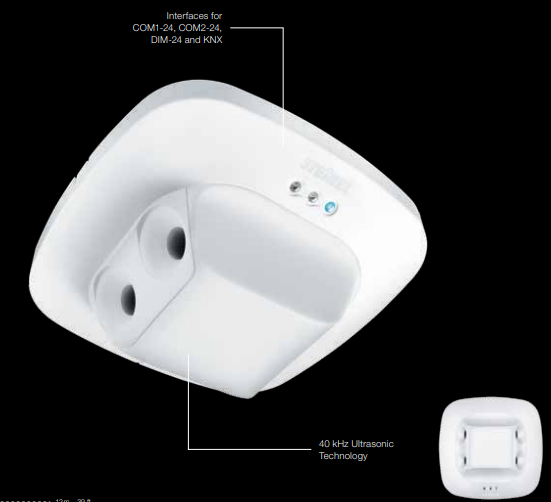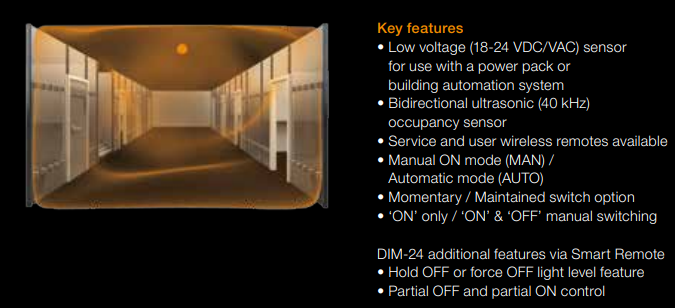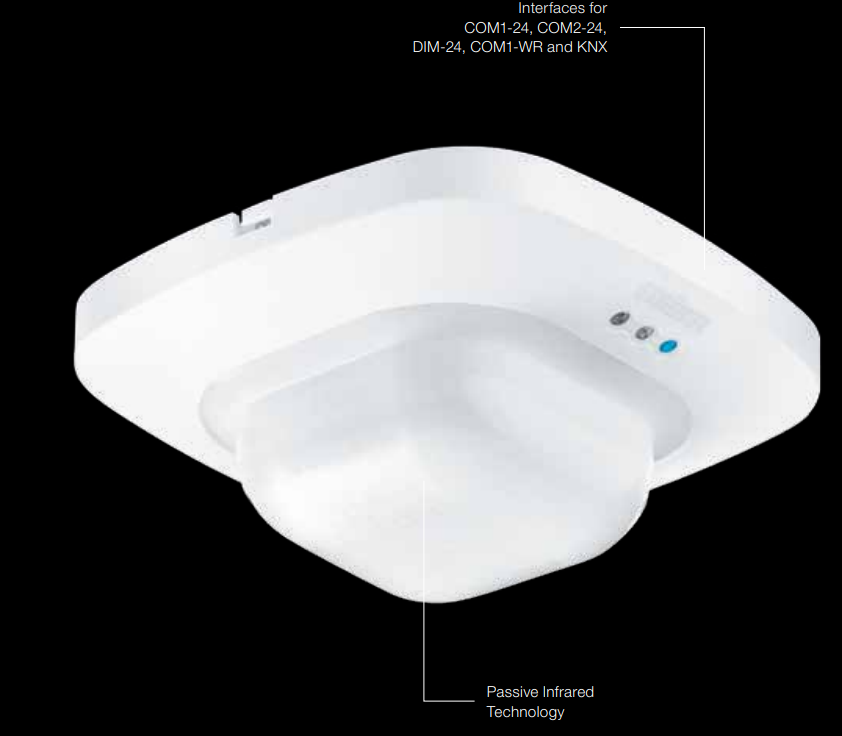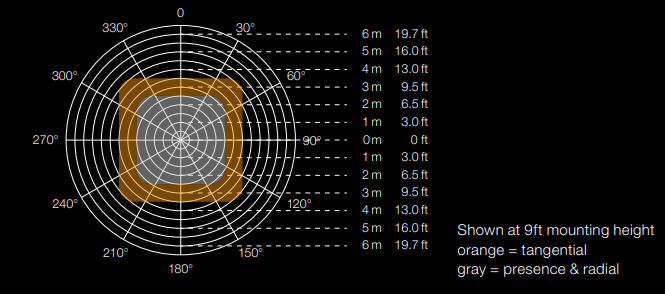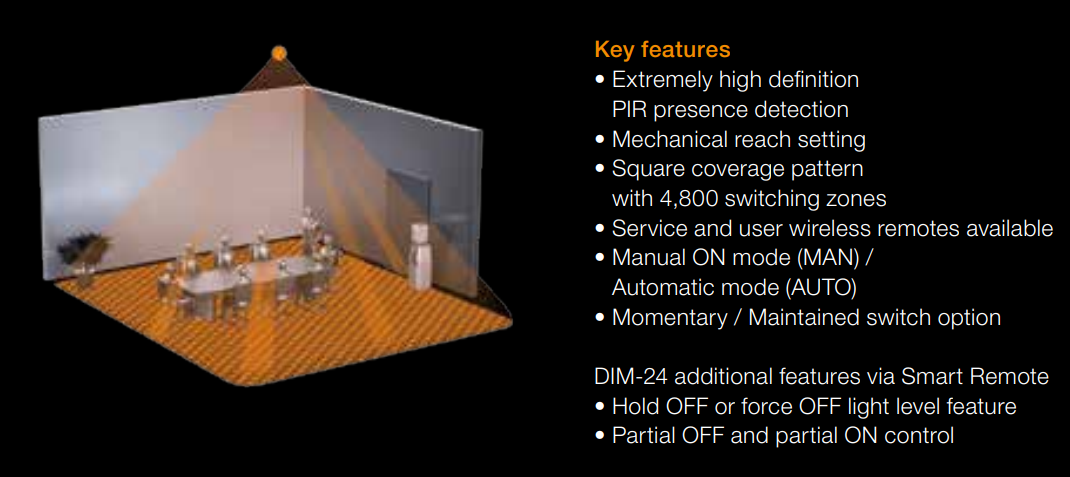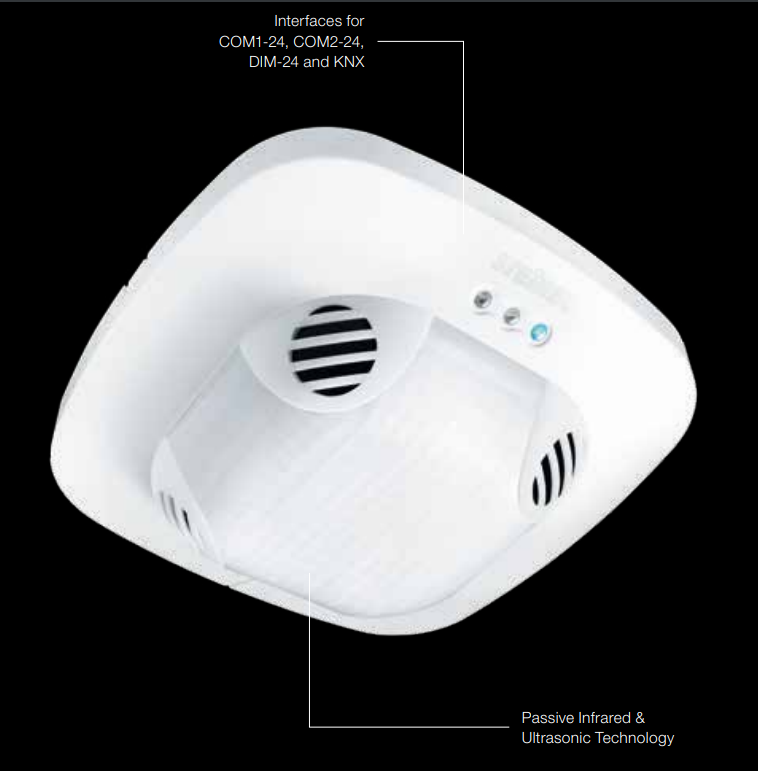Occupancy Sensor Technology
Occupancy sensors detect the motion or presence of an individual to control lights, adjust temperature and/or ventilation. In more sophisticated solutions, occupancy sensors can do much more.
Occupancy Sensor Technologies
Below are occupancy sensing technologies typicallly used on the market, each has its own operating characteristics, as well as strengths and weaknesses.
Passive Infrared (PIR): Passive infrared sensors measure infrared light radiating from objects in their field of view. This is a direct line of sight technology, meaning that if you can’t see the sensor, it can’t see you. Considering this is passive technology, the energy draw for these sensors is very low. As we move towards wireless sensors, most battery-powered sensors will use PIR. Active technologies, such as ultrasonic, draw more current and will drain the battery too quickly to be practical.
Ultrasonic (US): Ultrasonic sensors operate by emitting high-frequency sound waves into the space. These sound waves reflect off walls, other objects and back to the sensor. The sensors are triggered when a change is detected based on how sound waves bounce back. Due to how sound waves propagate, ultrasonic sensors can sense around corners, making these sensors suitable for locations where there are obstructions, such as cubical walls or bathroom stalls.
Dual Technology (DT): Dual technology sensors incorporate both PIR and ultrasonic, offering the best capabilities of both technologies. These sensors are suitable for the widest range of applications, and have a number of different settings to tailor their operation to the specific application. These settings typically include sensitivity adjustments that are independent for each technology, trigger settings, retrigger settings, and time delay. Trigger is a setting to determine what will turn the lights on. It can be set to have either of the technologies alone, both together, or one or the other. Retrigger is similar, but this is the sensor configuration that will keep the lights on once they are on. Adjustability of sensors is important to ensure that sensors operate optimally in each space where they are installed.
STEINEL has developed an unprecedented, comprehensive family of high quality, European made presence detectors.
US Hallway
US
Precise ultrasonic technology. Unique linear bidirectional coverage pattern. The US Hallway is a low voltage Ultrasonic Technology Occupancy Sensor (40 kHz) that utilizes STEINEL’s state of the art ultrasonic signal processing to provide superior stable volumetric bidirectional detection. The unique linear bidirectional coverage pattern is engineered specifically for hallways and applications requiring a true linear volumetric pattern of detection. This is an ideal hallway sensor for design and retrofit applications. Operational choices of manual ON or auto ON with either momentary or maintained switch options. Included light level feature provides the option to turn lights off when sufficient daylight is present for additional energy savings.
Applications: The typical best practice applications for the US Hallway sensors are: Hallways, tunnel walkways, sky walks, etc.
Coverage
Ultrasonic Detection:
max. 6.5x65ft (422.5sq.ft.)
max. 2x20m (40sq.m.) min. 6.5x20ft (130sq.ft.)
min. 2x5m (10sq.m.)
IR Quattro
PIR
The IR Quattro is a passive infrared presence detector setting a new standard in lighting control with minimal movement required for human presence detection. It features a single pyroelectric detector with a high performance lens system creating 1,760 switching zones. Operational choices of manual ON or auto ON with either momentary or maintained switch options. Included light level feature provides the option to turn lights off when sufficient daylight is present for additional energy savings. The innovative mechanical reach setting enables the designer with a precise method of controlling lighting zones by means of optimizing the sensors detection reach without compromising sensitivity providing true precise presence detection in the desired detection zone.
Applications: The typical application is for offices, conference rooms, classrooms and other indoor public building spaces.
Coverage:
1. Tangential:
motion perpendicular to the sensor max. 23x23ft (529sq.ft.)
max. 7.1x7.1m (50sq.m.)
2. Radial:
motion either directly toward or away from the sensor
max. 15x15ft (225sq.ft.)
max. 4.7x4.7m (22sq.m.)
3. Presence:
minor motion as described by NEMA WD7 with the additional requirement of both radial and tangential detection
max. 15x15ft (225sq.ft.)
max. 4.7x4.7m (22sq.m.)
IR Quattro HD
PIR
The IR Quattro HD is a high definition, passive infrared presence detector setting a new standard in lighting control with minimal movement required for human presence detection. Features four pyroelectric detectors with a high performance lens system that creates a new global standard in detection with 4,800 switching zones. Operational choices of manual ON or auto ON with either momentary or maintained switch options. Included light level feature provides the option to turn lights off when sufficient daylight is present for additional energy saings. The innovative mechanical reach setting enables the designer with a precise method of controlling lighting zones by means of optimizing the detection reach without compromising sensitivity providing precise presence detection in the desired detection zone.
Applications: The typical application is for offices, conference rooms, classrooms and other indoor public building spaces.
Coverage
1. Tangential:
motion perpendicular to the sensor
max. 65.5x65.5ft (4290sq.ft.)
max. 20x20m (400sq.m.)
2. Radial:
motion either directly toward or away from the sensor
max. 25.5x25.5ft (650sq.ft.)
max. 7.9x7.9m (62sq.m.)
3. Presence:
minor motion as described by NEMA WD7 with the additional requirements of both radial and tangential detection
max. 25.5x25.5 ft (650sq.ft.)
max. 7.9x7.9 m (62sq.m.)
DT Quattro
DT
The DT Quattro Dual Technology Presence Detector utilizes PIR and ultrasonic technologies to detect the presence or signature of a person in a space. The logic options for initial “ON” and “Maintained” state of occupancy gives design engineers and installation contractors the choice for proper control of lighting and building automation in difficult applications where detection options are needed in a single device. Lighting loads are controlled in relation to both presence detection and selectable ambient light levels with the integrated photocell to maximize energy savings. STEINEL’s world class PIR optics and ultrasonic signal processing provides unparalleled line of sight and volumetric presence detection. Operational choices of auto ON or manual ON with a momentary or maintained switch input. Applications: The typical application is for classrooms, conference rooms, computer rooms, storage rooms, workspaces and open office.
Coverage
1. Tangential:
motion perpendicular to the sensor
PIR: max. 13ft / 4m
US: up to 16.4ft / 5m
2. Radial: motion either directly toward or away from the sensor
PIR: max. 6.5ft / 2m
US: up to 16.4ft / 5m
3. Presence: minor motion as described by NEMA WD7 with the additional requirement of both radial and tangential detection
PIR: max. 10x10ft (100sq.ft.) / 3x3m (9sq.m.)
US: max. 20x20ft (400sq.ft.) / 6x6m (36sq.m.)

